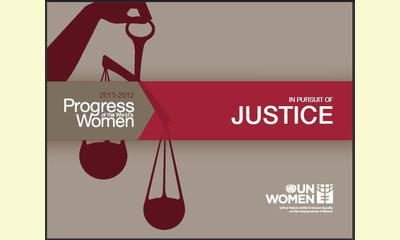|
|
Progress of the World’s Women: In Pursuit of Justice
un articulo por UN Women Watch and Progress UN Women
Justice remains out of reach for millions of the world’s women, a flagship report by UN Women warns. Progress of the World’s Women: In Pursuit of Justice is UN Women’s first major report, following the organization’s launch in early 2011.

click on photo to enlarge
This volume of Progress of the World’s Women starts with a paradox: the past century has seen a transformation in women’s legal rights, with countries in every region expanding the scope of women’s legal entitlements. Nevertheless for most of the world’s women, the laws that exist on paper do not translate to equality and justice.
In 1911, just two countries in the world allowed women to vote. A century later, that right is virtually universal and women are exercising greater influence in decision-making than ever before. Alongside women’s greater political influence, there has been a growing recognition of women’s rights, not only political and civil, but also economic, social and cultural rights.
Today, 186 countries worldwide have ratified the Convention on the Elimination of All Forms of Discrimination against Women (CEDAW), signalling their commitment to meeting the human rights of women and girls, breaking down the barriers to gender equality and justice.
And yet, while examples of countries making immense strides in promoting gender equality abound, all too often women are denied control over their bodies, denied a voice in decision-making and denied protection from violence. Some 600 million women, more than half the world’s working women, are in vulnerable employment, trapped in insecure jobs, often outside the purview of labour legislation.
Despite major progress on legal frameworks, millions of women report experiencing violence in their lifetimes, usually at the hands of an intimate partner. Meanwhile, the systematic targeting of women for brutal sexual violence is a hallmark of modern conflicts. . .
Although equality between women and men is guaranteed in the Constitutions of 139 countries and territories, inadequate laws and implementation gaps make these guarantees hollow promises, having little impact on the day-to-day lives of women . . .
Progress of the World’s Women shows that well-functioning legal and justice systems can be a vital mechanism for women to achieve their rights. They can shape society by providing accountability, by stopping the abuse of power and by creating new norms. . .
This report highlights the ways in which governments and civil society are working together to reform laws and create new models for justice service delivery that meet women’s needs. It demonstrates how they have risen to the challenge of ensuring that women can access justice in the most challenging of situations, including in the context of legal pluralism and during and after conflict.
Progress of the World’s Women outlines ten recommendations to make justice systems work for women. They are proven and achievable and, if implemented, they hold enormous potential to increase women’s access to justice and advance gender equality.
(Click here for a Spanish version of this article or here for a French version).
|








|
DISCUSSION
Pregunta(s) relacionada(s) al artículo :
Prospects for progress in women's equality, what are the short and long term prospects?
* * * * *
Comentario más reciente:
The following figures, very revealing, come from the website of the American White House.
. * . * . * . * .

. * . * . . ... continuación.

|
|










